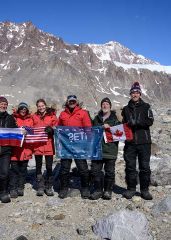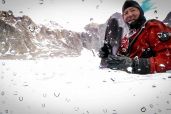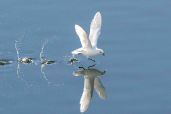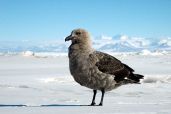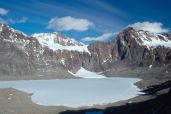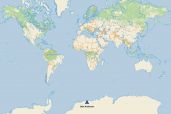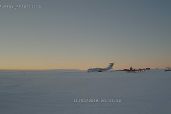Dale Andersen, Senior Research Scientist at the SETI Institute, is currently conducting field research in Antarctica. Follow along.
... and he will be locating, characterizing, and understanding environments where physical and chemical conditions approach or exceed the tolerances for life.
Follow along! View the location or send a reply to Dale Andersen: https://inreach.garmin.com/textmessage/txtmsg?extId=f7821a70-ace9-478f-a6fe-8bd86b2dfb0b (for the best view, select the aerial layer and zoom out).
- Read UPDATE 1 - OCT. 30 - NOV. 5, 2018
- Read UPDATE 2 - NOV. 9 -12, 2018
- Read UPDATE 3 - Nov. 19, 2018
- Read UPDATE 4 - Nov. 23, 2018
- Read UPDATE 5 - Nov. 24, 2018
- Read UPDATE 6 - Nov. 28, 2018
- Read UPDATE 7 - Nov. 30, 2018
- Read UPDATE 8 - Dec. 5, 2018
- Read UPDATE 9 - Dec. 12, 2018
- Read UPDATE 10 - Dec. 15, 2018
UPDATE 1 - OCT. 30 - NOV. 5, 2018
October 30, 2018
We arrived at the Novolazarevskaya ice runway Thursday evening via the ALCI chartered IL-76 about 8pm without incident; it is very nice to be back here again. We are early enough to enjoy a bit of darkness for several hours too, with a beautiful sunset off to the south of the station. We are staying at the ice-runway, and over the coming days we will prepare for the traverse to Untersee. Unfortunately, a storm arrived about 10 hrs. after we landed and we have been in whiteout conditions for the last two days with visibility of less than 50 meters.
The small blizzard blew out on Sunday, so yesterday was our first real day of work. After digging out the entrance (several hours) we pulled out our skidoos from storage, attached the sleds, and drove them down to Schirmacher Oasis and back to make sure they were working ok. Today we will begin organizing our cargo and gear for the traverse to Untersee - we hope to be there in 2-3 days, depending on how things go with our local logistics and weather. But so far, so good!
November 1, 2018
We had a busy day yesterday preparing for the traverse to Untersee. We should have everything in place by this afternoon and are scheduled to depart tomorrow morning if the weather is ok. I will try to have tracking set up on my Garmin InReach, so you can follow along.
November 2, 2018
Arrived Untersee 3pm UTC, all ok, first tent up.
View the location or send a reply to Dale Andersen: https://inreach.garmin.com/textmessage/txtmsg?extId=0ead8aef-0285-42e5-b764-3cfc4b489c7c&adr (for the best view, select the aerial layer, and zoom out)
November 3, 2018
We are at Lake Untersee now, three tents up with 45-50 knot winds keeping us company. Will try to give an update tomorrow, we are heading to bed early tonight since we had a very long day yesterday and today in blowing snow and wind. My sleeping bag is calling....
November 4, 2018
Today was a pretty productive day. We turned in early yesterday; everyone was pretty tired from the traverse the day before, followed by a day of getting two more tents up and a first cut at organizing the camp. Yesterday was another day with high winds and blowing snow, that made the work all the more tedious. But we awoke this morning to a quiet calm and after a quick breakfast we began the day with a quick snowmobile tour around the lake (its 6 km long) and continued setting up the camp. This afternoon we drilled through the 3.5 meters of ice to make sure we have fresh water for drinking and cooking the freeze-dried meals (a variety of BackPackers Pantry cuisine). Tomorrow we will begin putting up the diving tent and organize the science lab, getting generators online, etc. But, we will see what the weather brings us, which could impact our activities.
Cheers from Lake Untersee!
November 5, 2018
Just after getting a couple of tents set up today, the winds started pounding us with 60 knot gusts, and probably increasing this evening to what are likely 75-80 knot winds. We spent another few hours outside trying to protect our new homes; now we hope to stay indoors for a while as this storm moves by. We do have a metal sea container that could provide a safe-house if needed. But I do not think it will come to that!
November 6, 2018
Our winds have continued unabated likely hitting 40-50 m/s at times. We did lose four of our tents yesterday despite our best efforts to save them - the winds were just too much. But we are safe in another tent for the moment and we will rebuild the camp when the weather improves.
UPDATE 2 - NOV. 9 -12, 2018
November 9, 2018
The weather improved today with sunshine and light winds greeting us this morning, a nice change of pace from the constant pounding we have had the last few days. Late last night we had gusts hitting the 75-80 knot range again (or perhaps more) so it was pretty noisy until early this morning.
Today we replaced two of the Mountain Hardwear Stronghold tents and reinforced them quite a bit so they should be ok, or they just get flattened. Hope to get the two Weatherports up tomorrow if we are not getting pounded by winds again. Then we have one more stronghold to put up for the kitchen tent and we will be set. For the moment we are using the sea-container for our cooking tent (and sleeping the last few days). I still need to see if my diving compressor survive - the wind rolled its box (with tanks inside) about 10-15 m before dumping it.
We now have many more snow petrels in the area, quite a few arrived last night along with their nemesis, skuas. It’s nice to have the company!
November 12, 2018
The last two days have been pretty nice weather-wise, and very productive. We have replaced all of the tents lost to the storm and tomorrow we will complete the camp setup with the installation of the science tent, the second 10x12 ft Weatherport structure. We still have a few challenges ahead of us before we are able to engage in our scientific studies; nevertheless, slowly but surely we are getting there. Currently our camp consists of three Mountain Hardwear Stronghold tents, one Alaska Tarp & Tent pyramid tent, and one Weatherport.
This afternoon we also re-drilled the water-hole on the lake and refilled our two 20 liter Igloo water coolers, so we are set for water for a few days. During the next day or so, we need to organize the lab tent, get the hole-melter (for melting diving holes through the 3.5m thick lake ice) operational, and check to see if the dive compressor was damaged. Once we have confirmed that they both work we will start working on a dive hole for sampling. But not before the camp is fully operational, safe, and warm. Safety is the first consideration in all that we do, and having shelter from the elements comes ahead of all else.
UPDATE 3 - NOV. 19, 2018
We have just been busy trying to make up for lost time due to the previous storm and taking advantage of the relatively nice weather we have had lately. For the most part, the winds the last few days have been very manageable, although a couple of nights ago we were hitting 45 knots and gusting to 50 - this time the forecast accurately predicted these winds and our tents easily handled that night’s weather - unlike the previous storm, we simply had a noisy night with little sleep.
Having drilled holes through the ice of the two main basins of the lake ,we now have access for sampling and collecting water column profiles with the various scientific instruments we have with us. Yesterday I profiled the deepest part of the lake (161m) and today we spent most of the day collecting water in that same basin. Tomorrow we will head to the south basin (which is 100 m deep), repeating the same tasks there.
We are also interested in the ice-cover, and at each hole drilled we determine its thickness. At Lake Untersee, ice thickness can vary from about 2.5 m to 4 m across the lake; the variation being due to winds that buffet the lake unequally during the year.
We have many tasks to complete above the ice, but I am still hopeful that we will start working below the ice soon, too. My diving compressor was stored inside a large wooden crate during the storm that took out most of camp, and unfortunately that was one of the crates the winds rolled and tossed (despite being 150 kg), dropping it 10-15 m from where we had placed it. Fortunately the compressor survived the unexpected flight across the ice and it started up after warming it in my tent for a couple of days. However, the melter used to create the dive holes refused to ignite and we were unable to make a field repair. A Twin Otter was sent to our camp by ALCI and the melter was returned to the ice runway facility at Novolazarevskaya. It has since been repaired; now we just need to get it sent back out pending good flight conditions. Once we have the hole melter with us, we will make a dive hole and begin our diving operations beneath the ice. The melter will also be used to help retrieve scientific sensors and sampling devices that were deployed last year.
UPDATE 4 - Nov. 23, 2018
We had a very blustery night which made for very noisy tents, but the camp is intact so we are in good shape thus far. We will see what the forecast suggests later when it is sent around, but yesterday’s forecast had the storm moving in last night and lasting through Saturday. So we are not too sure if we will see increased winds or perhaps get lucky and have this system move by quickly. For the moment, we are not able to do much outside since the gusts are too high for working on the lake ice.
UPDATE 5 - NOV. 24, 2018

Last night was a bit noisy with 40-50 knot winds rattling the tents, but they were not destructive, so all is well here at Lake Untersee. As we approach the Antarctic summer, our air temperatures will rise quite a bit, nearing and at times just exceeding the freezing point. Today we have -2°C, low clouds and 10 knot winds, occasionally gusting to 20-30 knots. At least on this side of the lake - in the SE corner winds can be considerably higher which can limit work there. We need to drill a few more holes and collect sediment samples there, so that may be on our to-do list tomorrow.
Fortunately, the latest forecast has a significant improvement in the weather arriving tomorrow afternoon (Sunday) and remaining with us through at least Tuesday. Monday afternoon, weather permitting, the twin otter will drop by with the hole melter, either landing on the lake, or, if needed, 6 miles to the north on the Anuchin Glacier. If all goes well, we will begin melting a dive hole on Monday afternoon and, barring any further challenges, we should be diving by next Wednesday or Thursday.
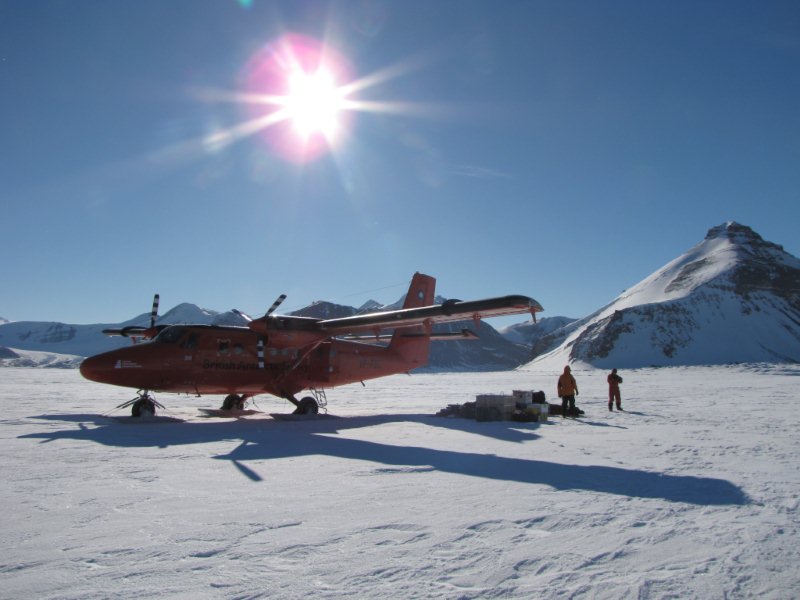
UPDATE 6 - NOV. 28, 2018
The hole melter was returned, but unfortunately it still does not work properly and we are unable to use it to make a dive hole or melt out the light sensors we left in the water column last year. And while I am disappointed we will not be working underwater, we have moved on to other important areas of work that will occupy our time during the next two weeks. Over the last several days we drilled additional holes in the south basin as part of an effort to increase the accuracy of the bathymetry map for the lake and to make measurements of ice-thickness; the ice-thickness data are to be used to model variations in ablation across the lake. We also used one hole to obtain samples with an Ekman dredge from the deepest point (100 m) in the south basin. These samples are currently having DNA and RNA extracted and preserved for genomic studies that will take place in the coming months and other subsamples are being preserved for additional geochemical analyses as well.
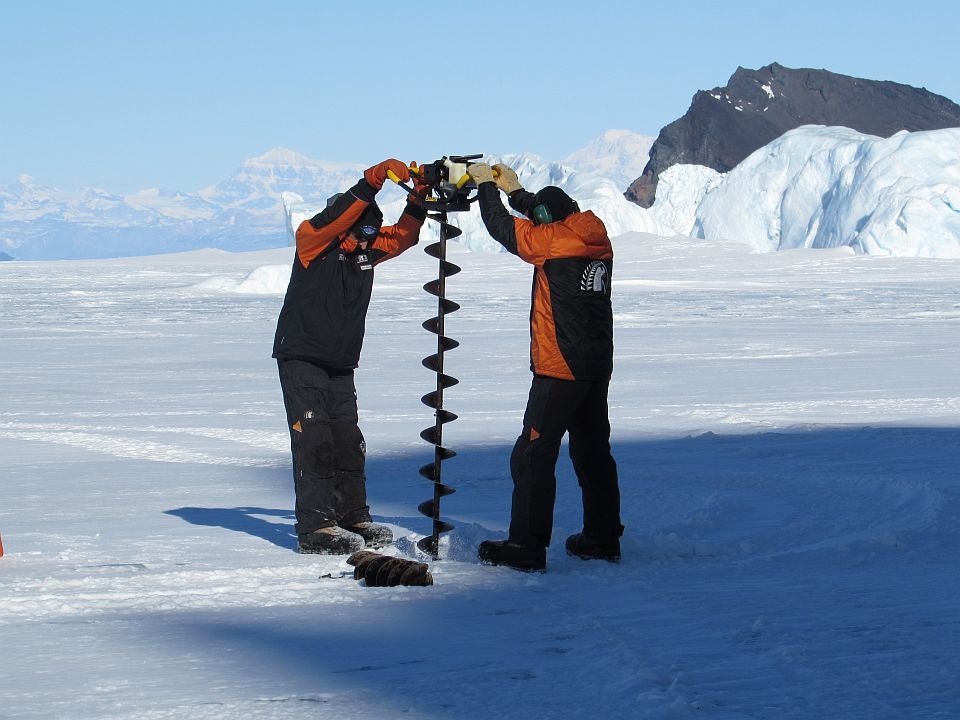
Our resident lichenologist Mikhail Andreev has been searching for lichens and although somewhat rare, he has identified at least a half-dozen species that are present at Untersee. Climatically, Untersee Oasis is extremely dry, making it difficult for lichens or moss to colonize the rocks and soils in this area. But Mikhail will continue to search for those species that have managed to adapt to the extremes here.
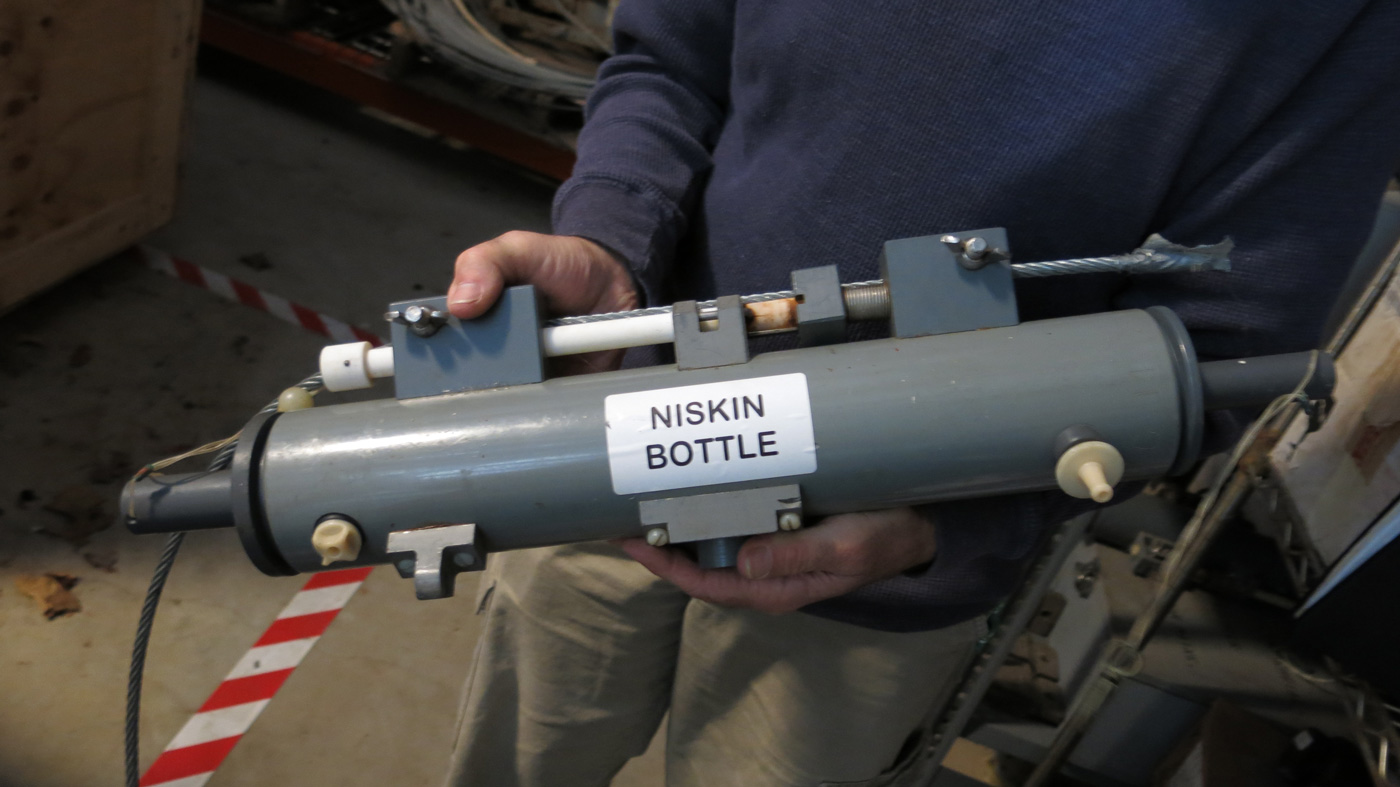
Over the next several days, we will collect sediments from the deepest region (161 m) of the lake as well and make additional ice-thickness measurements. I need to tend to the climate stations we have deployed here over the last 10 years too - ensuring they are working properly, downloading new data and, if time permits, deploying a new station at nearby Lake Obersee (1 hour drive by snowmobile from Untersee).
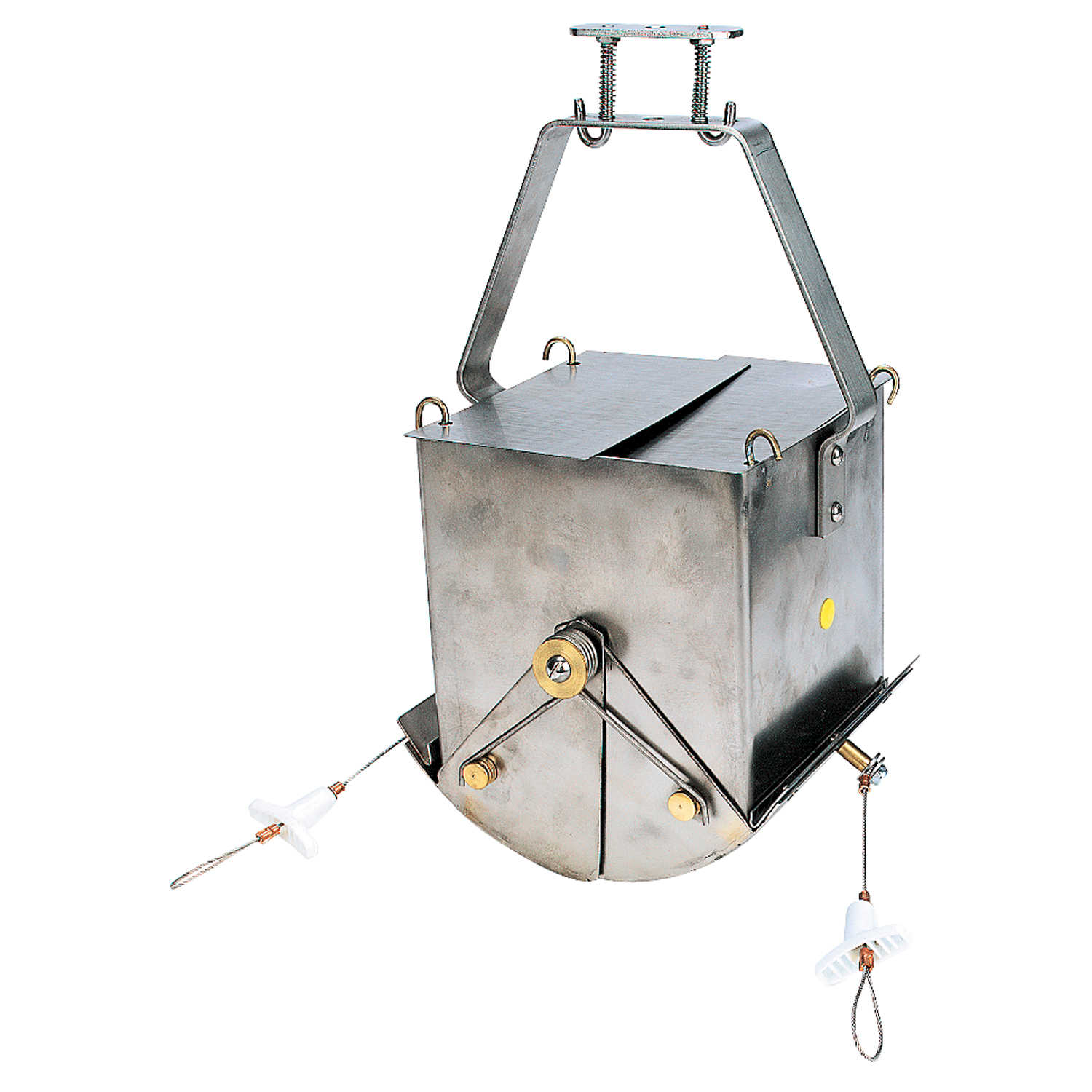
We will see how it goes - presently the weather is quite nice with sunny skies and warm temperatures hovering just below and above the freezing point. Fortunately the winds have been very light as well, but that will likely change in the next few days and we can expect winds to return to the more normal 20 -40 knot range again. But we will certainly take advantage of and enjoy the clement conditions for as long as we can!
UPDATE 7 - NOV. 30, 2018
As for Untersee news - we have been busy drilling additional holes in the ice for bathymetry and ice-thickness measurements, and today was a major day for collecting samples in the nearby Aurkjosen Cirque basin, just to the east of the lake. This small ‘dry valley’ once hosted a lake that was about 50 m deep but after its water supply was cut off via the retreat of the Anuchin Glacier, it dried down, leaving only a sedimentary record behind. In areas that have been protected from wind scouring, preserved microbial mats can be found, buried in the lacustrine clays. Samples from the Aurkjosen Cirque are undergoing sample analysis at NASA Ames (Mary Beth Wilhelm and Linda Jahnke) and at Georgetown University in Sarah Johnson’s lab, and the samples we collect now will also be subsequently be analyzed in the Johnson Lab - but this time we are taking additional precautions for preserving them during transport by keeping sets of samples at very low temps - that of liquid nitrogen - in cryoshippers that will be returned to the US after we complete our work here.
We are also continuing to work on the climate stations that are located here and hopefully we will deploy a new one at nearby Lake Obersee in a couple of days if the weather continues to be nice. Today was mostly sunny with light winds and temps about -6°C, so no complaints!
UPDATE 8 - Dec. 5, 2018
The last few days have been very nice with mild temperatures (-7°C to +2°C), sunshine and little wind. We used this time to complete many of the tasks on our "to do" list including drilling additional holes in the lake ice to determine ice-thickness and depth, collecting sediment samples from the deepest region of the lake in the northern basin (161 meters), obtaining soil samples in areas above the lake where one finds water wicking from snow/melted ice into adjacent soils (a terrestrial analog of slope-streaks on Mars), maintenance of the climate stations at Untersee and in the nearby Aurkjosen Cirque, deployment of a new climate station at Lake Obersee and continued investigations of lichens (and a few mosses) on the slopes and mountains surrounding the lake.
Last night low clouds moved over us, resulting in overcast skies, and the winds have picked up, sometimes gusting to 40 knots. We expect today and tomorrow to be windy with a few flurries, but we are not expecting a large storm. Yesterday I downloaded and looked over the Untersee climate data for the first few days after our arrival, and confirmed my earlier estimates that the winds that destroyed our camp just after our arrival were frequently gusting to just under 50 meters/second - almost 112 MPH! Hopefully we will not see winds that strong again during our remaining time here at Untersee, but one can never be certain.
We are in our final stretch now, our departure has been set for 14 Dec at which time we will make the traverse back to the ice-runway at Novolazarevskaya Station. We will begin packing the camp on the 10th, so we only have another 4-5 days for science before we must start heading home!
UPDATE 9 - Dec. 12, 2018
The last week and a half has seen a lot of variability in the weather with katabatics visiting us frequently - this morning at 6am we had gusts hitting 50 knots. But it has, for the most part, been clear and very warm and when the sun is out, our air temperatures are a few degrees above zero. But our relative humidity remains quite low, currently at 18%. The very warm, dry katabatics evaporates most liquid water that forms from melting snow and ice so despite the new-found warmth, the area is pretty dry.
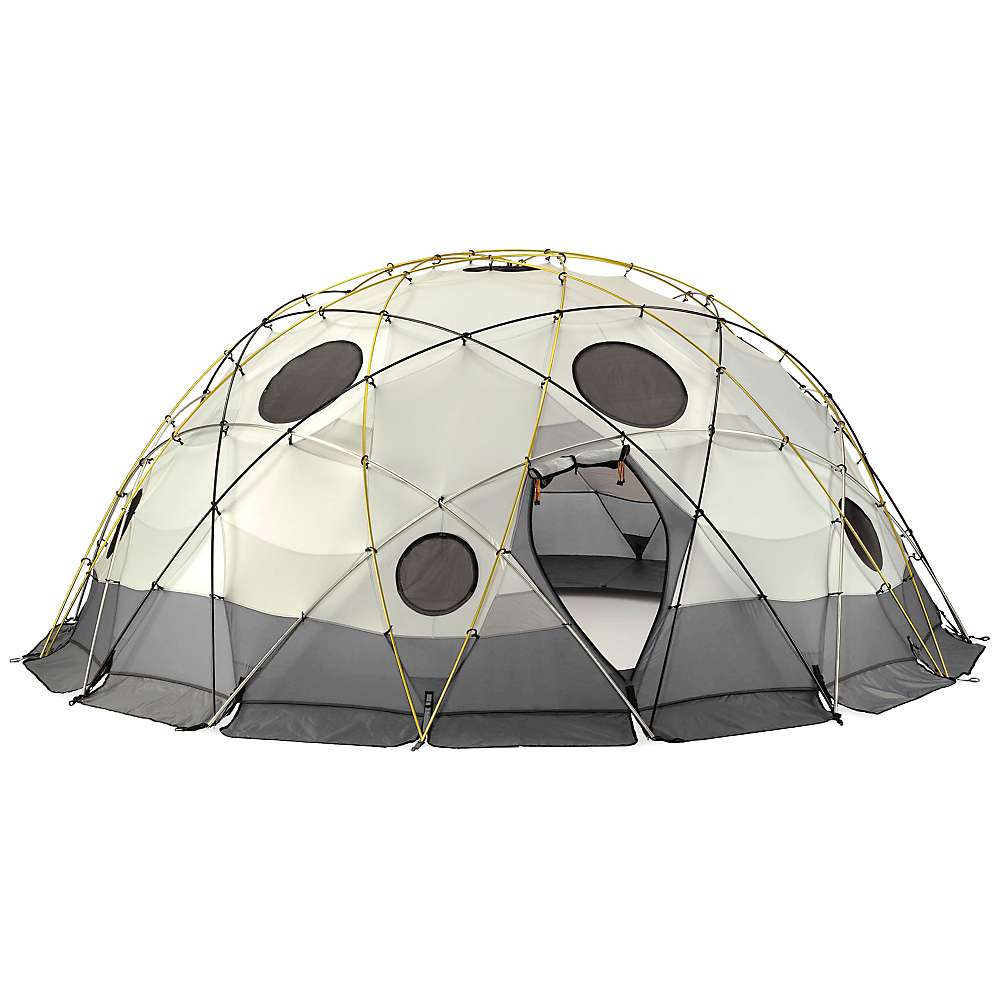
Having completed most of our science objectives, we are now preparing for our departure on Friday. We have taken down the two Weatherports used for the science tent and diving tent and today we will take down the "cook-tent" - one of three Mountain Hardwear Stronghold tents that are in place. The other two Stronghold tents will stay up until Friday morning, pulling them down just before we depart. Thursday (tomorrow) ALCI will send out Everest and several sleds, and once it is here we will load it up. Friday morning we will make the traverse back to Novo, three of us by snowmobile and three riding in a small cabin on one of the sleds attached to Everest.
We have one or two small science tasks remaining and we will complete them today. One involves placing 5 m long lines (white parachute cord) into several of the holes we drilled through the ice; there they will freeze in and as ice is added at the bottom and ablated away at the top, the lines will help provide estimates of the annual ablation rates across the lake. Next year we will relocate the lines and measure how much line has escaped during our absence.
UPDATE 10 - Dec. 15, 2018
The camp at Lake Untersee is now closed; we pulled the last three tents down early yesterday morning and completed packing our cargo into the sea container, with the remainder going onto the other two cargo sleds. The traverse back went well and we are all back at Novolazarevskaya Station, now at the ALCI operated "Oasis Huts" just adjacent to the Russian Station Novolazarevskaya. We have stayed in the Oasis Huts many times over the years so it is like returning to our home away from home - warm beds, good food, hospitality, and a place to wash off the last six weeks of wear and tear we have all accumulated. These huts, refurbished a few years ago, were built in the early 1960s by the Russian Antarctic program - the initial Novolazarevskaya Station - so it is always nice to be staying somewhere with an interesting history.
We will work with our cargo here for a couple of days making sure it all properly stored for future use during the next field season. On the 18th we will fly to Cape Town on an ALCI chartered Boeing 757 that will land on the ice runway. Barring any problems we should be in Cape Town around 7am on the 19th, and once there we will prepare for flights back to our respective homes in the USA and Canada. Our Russian colleague, Mikhail, will remain here at Novo Staton, continuing his field work in the Schirmacher Oasis, and then continuing around the Antarctic continent to Progress Station, where he wil investigate lichens in the Larsman Hills before returning home in Saint Petersburg.
All in all, a great field season and we accomplished most of what we set out to do. Now it is time to head home, relax a bit over the holidays, and then begin working on returned samples, analyzing data, and planning for future work in this region.
Check out our current location https://inreach.garmin.com/textmessage/txtmsg?extId=f7821a70-ace9-478f-a6fe-8bd86b2dfb0b

